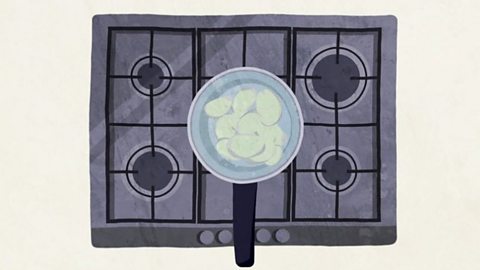Is your cooking burning money and energy?
Making small changes to how you cook can have a surprisingly big impact on your carbon footprint. Of course, emissions created by cooking depend partly on where your energy comes from ÔÇô fossil fuels or clean energy. But whatever your energy source, here are simple, inexpensive tips to reduce the greenhouse gas emissions from your cooking.
Watch our 90-second animation for tips on how to reduce the carbon cost of cooking.
Simple tip for saving energy when boiling
There are easy ways to save energy when boiling or simmering food. For example, the carbon cost of 200g boiled potatoes is about 106-216g CO2 equivalent, of which 50-160g is from boiling, according to Mike Berners-Lee in his book How Bad are Bananas.
Lots of variables affect the energy cost of boiling potatoes or other foods. Here are some notable factors you can easily change:
- Excess water requires more energy to heat.
- If the potatoes are in large pieces theyÔÇÖll need longer to cook.
- Boiling furiously uses a lot of energy, but the water temperature and therefore cooking speed will be exactly the same if the water is gently simmered because it never exceeds 100┬░C.
- If your pan has no lid, the process will require more energy, as water will dissipate into the air ÔÇô remember, you can use that steam to cook other foods, such as soft veg and fish, if you have a steamer and a lid.
Once your potatoes are cooked, use the hot water to cook other things such as veg or eggs, rather than pouring it away. Anything you donÔÇÖt want to eat straight away can go in the fridge or the freezer.

Ways to save energy when baking and roasting
ÔÇťSwitching the oven on for 2 hours causes about 2.5kg of emissionsÔÇŁ, according to SL Bridle in her book Food and Climate Change Without the Hot Air. ThatÔÇÖs much more than the emissions caused by taking a generous bath (1.6kg if heated by electricity according to Berners-Lee), or drinking a pint of UK cowÔÇÖs milk (1.1kg). One solution is to try to fill up your oven whenever you turn it on ÔÇô it could save you time as well as reducing your carbon footprint. You can even cook just once a week and eat well every day, putting anything youÔÇÖre not eating in the fridge or freezer.
Likewise, preheating the oven for longer than you need to wastes a lot of energy. Lots of dishes will cook perfectly well in the oven without preheating it.
Reheating food in a microwave instead of the oven is an easy way to cut your carbon emissions. Baking a potato in the microwave uses a small percentage of the energy required to bake it in the oven.
Consider whether you can use a more efficient cooking method than the oven for your ingredient. ÔÇťGHGE [greenhouse gas emissions] can be reduced [by] between 40 percent and more than three-fold by avoiding cooking in the oven and choosing preparation methods that require less cooking timeÔÇŁ, writes Dr Christian Reynolds, senior lecturer in the Centre for Food Policy at City University London, in a . He adds that when it comes to meat, ÔÇťroasting or baking in theoven is the environmental worst cooking option since long cooking times are required, increasing emissions more thanthree-fold compared to frying on the stoveÔÇŁ.
Energy-saving kitchen gadgets
Kitchen appliances and gadgets have different carbon costs. Here are some tips:
- Fan-assisted ovens are generally more efficient than conventional ones, as they do a better job of circulating heat.
- An induction hob is usually more energy-efficient than a gas or standard electric hob, as it heats the pan directly using an electromagnetic field, so there is no heating element and therefore no wasted heat energy.
- Kettles are usually the most efficient way of heating water, but they vary widely in efficiency, depending on how well insulated they are. If your kettle gets very hot, itÔÇÖs likely youÔÇÖre losing a lot of energy through its walls. Remember to only boil as much water as you need.
- Another energy-efficient kitchen star is the pressure cooker ÔÇô its pressurized environment allows for cooking at higher temperatures, which speeds up the process and so lowers the energy requirements.
- Of course, microwaves are an energy-efficient way of cooking.